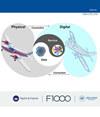Spatial-temporal data analysis of digital twin
引用次数: 2
Abstract
Background: Digital Twin (DT) has proven to be one of the most promising technologies for routine monitoring and management of complex systems with uncertainties. Methods: Our work, which is mainly concerned with heterogeneous spatial-temporal data, focuses on exploring data utilization methodology in DT. The goal of this research is to summarize the best practices that make the spatial-temporal data analytically tractable in a systematic and quantifiable manner. Some methods are found to handle those data via jointly spatial-temporal analysis in a high-dimensional space effectively. We provide a concise yet comprehensive tutorial on spatial-temporal analysis considering data, theories, algorithms, indicators, and applications. The advantages of our spatial-temporal analysis are discussed, including model-free mode, solid theoretical foundation, and robustness against ubiquitous uncertainty and partial data error. Finally, we take the condition-based maintenance of a real digital substation in China as an example to verify our proposed spatial-temporal analysis mode. Results: Our proposed spatial-temporal data analysis mode successfully turned raw chromatographic data, which are valueless in low-dimensional space, into an informative high-dimensional indicator. The designed high-dimensional indicator could capture the ’insulation’ correlation among the sampling data over a long time span. Hence it is robust against external noise, and may support decision-making. This analysis is also adaptive to other daily spatial-temporal data in the same form, for example in a digital substation such as Cai Lun. Conclusions: This exploration and summary of spatial-temporal data analysis may benefit the fields of both engineering and data science.数字孪生的时空数据分析
背景:数字孪生(DT)已被证明是对具有不确定性的复杂系统进行日常监测和管理的最有前途的技术之一。方法:我们的工作主要涉及异构时空数据,重点探索DT中的数据利用方法。本研究的目标是总结最佳实践,使时空数据能够以系统和可量化的方式进行分析处理。发现了一些方法可以在高维空间中通过联合时空分析有效地处理这些数据。我们提供了一个关于时空分析的简明而全面的教程,考虑了数据、理论、算法、指标和应用。讨论了我们的时空分析的优势,包括无模型模式、坚实的理论基础以及对普遍存在的不确定性和部分数据误差的鲁棒性。最后,我们以中国一个实际数字变电站的状态检修为例,验证了我们提出的时空分析模式。结果:我们提出的时空数据分析模式成功地将低维空间中无价值的原始色谱数据转化为信息丰富的高维指标。设计的高维指标可以捕捉长时间内采样数据之间的“绝缘”相关性。因此,它对外部噪声具有鲁棒性,并可能支持决策。这种分析也适用于相同形式的其他日常时空数据,例如在蔡伦这样的数字变电站中。结论:这种对时空数据分析的探索和总结可能有利于工程和数据科学领域。
本文章由计算机程序翻译,如有差异,请以英文原文为准。
求助全文
约1分钟内获得全文
求助全文
来源期刊

Digital Twin
digital twin technologies-
自引率
0.00%
发文量
0
期刊介绍:
Digital Twin is a rapid multidisciplinary open access publishing platform for state-of-the-art, basic, scientific and applied research on digital twin technologies. Digital Twin covers all areas related digital twin technologies, including broad fields such as smart manufacturing, civil and industrial engineering, healthcare, agriculture, and many others. The platform is open to submissions from researchers, practitioners and experts, and all articles will benefit from open peer review.
The aim of Digital Twin is to advance the state-of-the-art in digital twin research and encourage innovation by highlighting efficient, robust and sustainable multidisciplinary applications across a variety of fields. Challenges can be addressed using theoretical, methodological, and technological approaches.
The scope of Digital Twin includes, but is not limited to, the following areas:
● Digital twin concepts, architecture, and frameworks
● Digital twin theory and method
● Digital twin key technologies and tools
● Digital twin applications and case studies
● Digital twin implementation
● Digital twin services
● Digital twin security
● Digital twin standards
Digital twin also focuses on applications within and across broad sectors including:
● Smart manufacturing
● Aviation and aerospace
● Smart cities and construction
● Healthcare and medicine
● Robotics
● Shipping, vehicles and railways
● Industrial engineering and engineering management
● Agriculture
● Mining
● Power, energy and environment
Digital Twin features a range of article types including research articles, case studies, method articles, study protocols, software tools, systematic reviews, data notes, brief reports, and opinion articles.
 求助内容:
求助内容: 应助结果提醒方式:
应助结果提醒方式:


